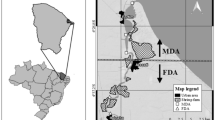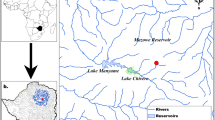Abstract
The population living along the riverbanks of the Amazon basin depends heavily on fish for nutritional support. Mono-methyl-mercury (MMHg) concentrates in fish, which can contaminate humans, the risk depending not only on fish MMHg concentration but also on the amount of fish consumed. We sampled nine locations of the Rio Negro basin, differing in water pH, Hg concentrations, and dissolved organic carbon (DOC), and determined total Hg from 951 fish samples of species representative of the food web: herbivorous, detritivorous, omnivorous, and piscivorous. Mercury concentrations varied widely in all species but showed a trend that depended on fish feeding strategies. The highest mean concentration was found in the piscivorous species (688.90 ng/g−1), followed by omnivorous (190.30 ng/g−1), detritivorous (136.04 ng/g−1), and herbivorous (70.39 ng/g−1). Fish Hg concentrations exceeding current safe limits (500 ng/g−1) for human consumption were found mainly in the piscivorous species (60%). Significant positive correlation between fish weight and Hg concentration was seen for the piscivorous Serrasalmus spp. (n = 326; r = 0.3977; p < 0.0001), Cichla spp. (n = 125; r = 0.4600; p < 0.0001), and Pimelodus spp. (n = 12; r = 0.8299; p = 0.0008), known locally as Piranha, Tucunaré, and Mandi, respectively. However, a negative correlation was seen for nonpiscivorous Potamorhina latior (n = 30; r −0.3763; p = 0.0404) and Leporinus spp. (n = 44; r = −3987; p = 0.0073), known as Branquinha (detritivorous) and Aracu (omnivorous). Fish-Hg concentrations in the acidic waters (pH range, 4.09–6.31) of the Rio Negro habitat, with its wide gradient of Hg concentrations (3.4–11.9 μg/L−1) and DOC (1.85–15.3 mg/L−1)—but no history of gold mining activity—are comparable to other Amazonian rivers. Opportunity fish catches in the Rio Negro habitat show high muscle-Hg derived from natural sources, but no systematic association with site-dependent geochemistry.
Similar content being viewed by others
Author information
Authors and Affiliations
Rights and permissions
About this article
Cite this article
Barbosa, ., Souza, ., Dórea, . et al. Mercury Biomagnification in a Tropical Black Water, Rio Negro, Brazil. Arch Environ Contam Toxicol 45, 235–246 (2003). https://doi.org/10.1007/s00244-003-0207-1
Issue Date:
DOI: https://doi.org/10.1007/s00244-003-0207-1




